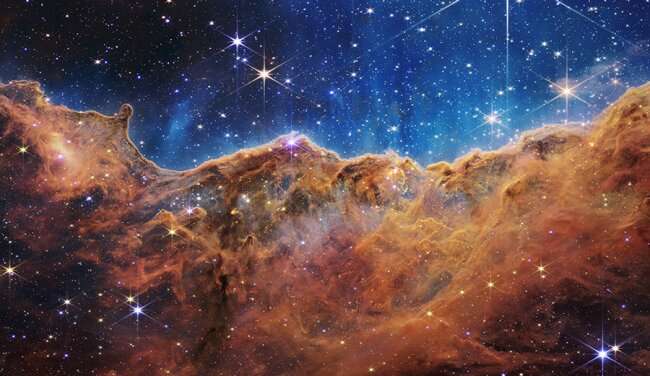Credit: NASA, ESA, CSA, and STScI
There's a new, immersive way to explore some of the first full-color infrared images and data from NASA's JWST—through sound. Listeners can enter the complex soundscape of the Cosmic Cliffs in the Carina Nebula, explore the contrasting tones of two images that depict the Southern Ring Nebula, and identify the individual data points in a transmission spectrum of hot gas giant exoplanet WASP-96 b.
A team of scientists—including Kim Arcand of the Center for Astrophysics | Harvard & Smithsonian—musicians, and a member of the blind and visually impaired community worked to adapt JWST's data, with support from the JWST mission and NASA's Universe of Learning.
"Music taps into our emotional centers," says Matt Russo, a musician and physics professor at the University of Toronto. "Our goal is to make Webb's images and data understandable through sound—helping listeners create their own mental images."
These audio tracks support blind and low-vision listeners first, but are designed to be captivating to anyone who tunes in.
"These compositions provide a different way to experience the detailed information in Webb's first data. Similar to how written descriptions are unique translations of visual images, sonifications also translate the visual images by encoding information, like color, brightness, star locations, or water absorption signatures, as sounds," says Quyen Hart, a senior education and outreach scientist at the Space Telescope Science Institute in Baltimore, Maryland. "Our teams are committed to ensuring astronomy is accessible to all."
Credit: Harvard-Smithsonian Center for Astrophysics
This project has parallels to the "curb-cut effect," an accessibility requirement that supports a wide range of pedestrians.
"When curbs are cut, they benefit people who use wheelchairs first, but also people who walk with a cane and parents pushing strollers," explains Arcand, a visualization scientist at the Chandra X-ray Center who led the initial data sonification project for NASA and now works on it on behalf of NASA's Universe of Learning. "We hope these sonifications reach an equally broad audience."
Preliminary results from a survey Arcand led showed that people who are blind or low vision, and people who are sighted, all reported that they learned something about astronomical images by listening. Participants also shared that auditory experiences deeply resonated with them.
"Respondents' reactions varied—from experiencing awe to feeling a bit jumpy," Arcand continues. "One significant finding was from people who are sighted. They reported that the experience helped them understand how people who are blind or low vision access information differently."
Credit: Harvard-Smithsonian Center for Astrophysics
These tracks are not actual sounds recorded in space. Instead, Russo and his collaborator, musician Andrew Santaguida, mapped Webb's data to sound, carefully composing music to accurately represent details the team would like listeners to focus on. In a way, these sonifications are like modern dance or abstract painting—they convert Webb's images and data to a new medium to engage and inspire listeners.
Christine Malec, a member of the blind and low vision community who also supports this project, said she experiences the audio tracks with multiple senses. "When I first heard a sonification, it struck me in a visceral, emotional way that I imagine sighted people experience when they look up at the night sky."
There are other profound benefits to these adaptations. "I want to understand every nuance of sound and every instrument choice, because this is primarily how I'm experiencing the image or data," Malec continues.
Overall, the team hopes that sonifications of Webb's data help more listeners feel a stronger connection to the universe—and inspire everyone to follow the observatory's upcoming astronomical discoveries.
Credit: Harvard-Smithsonian Center for Astrophysics
These sonifications are a result of a collaboration between the NASA's Universe of Learning program and the JWST. The Chandra X-ray Center (CXC) leads data sonification as a NASA's Universe of Learning partner. Science experts affiliated with the JWST mission provide their expertise on JWST observations, data, and targets.
Provided by Harvard-Smithsonian Center for Astrophysics
























